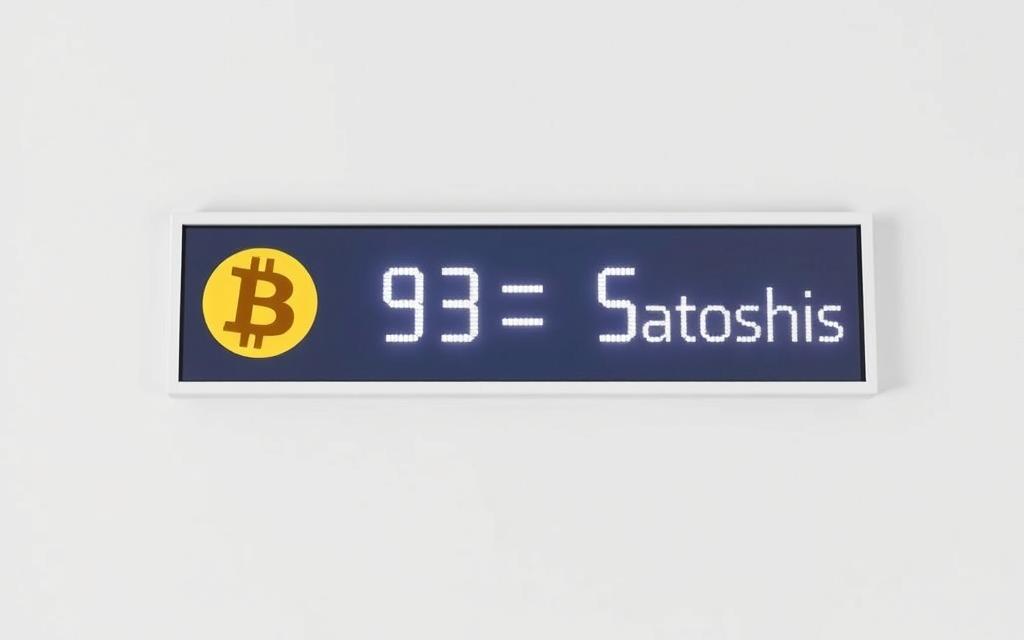Table of Contents
Bitcoin has revolutionized the way we think about money, and one of its most fascinating aspects is its divisibility. While most people know Bitcoin as a single unit, it can be broken down into smaller parts called “satoshis.”
This divisibility makes Bitcoin accessible to more people by enabling microtransactions and small investments in the cryptocurrency market. Understanding the relationship between satoshis and BTC is crucial for navigating the cryptocurrency ecosystem.
The value of satoshis is derived from Bitcoin’s market price, making it essential for investors and users to grasp this concept for everyday transactions and investments.
What Is a Satoshi?
The term “satoshi” is derived from the pseudonymous creator of Bitcoin, Satoshi Nakamoto. Understanding the concept of a satoshi is essential for navigating the world of cryptocurrency, as it represents the fundamental unit of Bitcoin.
The Smallest Unit of Bitcoin
A satoshi is the smallest unit of Bitcoin, equivalent to 0.00000001 BTC. This precision allows for microtransactions, making Bitcoin more versatile and accessible for various uses. The ability to transact in satoshis rather than whole Bitcoins facilitates the adoption of Bitcoin for everyday transactions.
Named After Bitcoin’s Creator
The decision to name the smallest unit of Bitcoin after Satoshi Nakamoto pays tribute to the enigmatic figure behind the cryptocurrency. Nakamoto’s white paper, published in 2008, laid the groundwork for the development of blockchain technology and the crypto industry as we know it today. The naming convention not only honors Nakamoto’s contribution but also reinforces the decentralized and innovative spirit of the Bitcoin blockchain.
| Unit | Value in BTC |
|---|---|
| 1 Bitcoin | 1 BTC |
| 1 Satoshi | 0.00000001 BTC |
As quoted by Satoshi Nakamoto in the Bitcoin white paper, “The root problem with conventional currency is all the trust that’s required to make it work.” This foundational principle underscores the significance of the satoshi in the broader context of cryptocurrency and blockchain technology.
“A satoshi is to Bitcoin as a cent is to the dollar, but while cents are physical, satoshis exist purely on the blockchain.”
How Many Satoshis in a Bitcoin?
As Bitcoin’s price continues to rise, grasping the concept of satoshis becomes increasingly important. Bitcoin is divisible into smaller units, making it accessible to a wider range of investors.
The 100 Million Ratio
One Bitcoin is equivalent to 100 million satoshis. This ratio is fundamental to understanding Bitcoin’s divisibility. With the price of Bitcoin being substantial, this division allows for flexibility in transactions.
Common Bitcoin to Satoshi Conversions
Understanding common conversions can help new users grasp the relationship between Bitcoin and satoshis more intuitively. For instance, 0.1 BTC equals 10 million satoshis, 0.01 BTC equals 1 million satoshis, and 0.001 BTC equals 100,000 satoshis. These conversions demonstrate that meaningful Bitcoin ownership doesn’t require purchasing a whole bitcoin.

The Value of a Satoshi
As Bitcoin continues to gain traction, understanding the value of its smallest unit, the satoshi, becomes increasingly important. The value of a satoshi is not static; it fluctuates based on Bitcoin’s market price. This dynamic nature of satoshi value is crucial for users to understand, especially when making transactions or investment decisions.
How Satoshi Value Fluctuates with Bitcoin Price
The value of one satoshi is directly tied to the current market price of Bitcoin. For instance, if Bitcoin’s market price is $21,970.70, then one satoshi is worth $0.000219707. This value changes as Bitcoin’s price moves. Many cryptocurrency platforms now display prices in both Bitcoin and satoshi equivalents to provide better context for users. You can use a Satoshi to Bitcoin conversion calculator to easily switch between the two units.
Current Value in USD
At current Bitcoin prices, one satoshi is worth a fraction of a cent in USD terms. The current USD value of a satoshi can be calculated by dividing Bitcoin’s price by 100 million. For example, if Bitcoin is priced at $21,970.70, one satoshi equals $0.000219707. This tiny value enables precise transactions that wouldn’t be possible with traditional currency, making satoshis particularly useful for microtransactions.
Converting Between Bitcoin and Satoshis
Converting between Bitcoin and Satoshis is a straightforward process that requires a simple mathematical formula. This conversion is essential for understanding the value of Bitcoin transactions, whether you’re dealing with whole Bitcoins or smaller Satoshis units.
Bitcoin to Satoshi Formula
To convert Bitcoin to Satoshis, you use the formula: Number of Satoshis = Amount of Bitcoin × 100,000,000. For instance, if you have 0.01 Bitcoin, the calculation would be 0.01 × 100,000,000 = 1,000,000 Satoshis. This conversion is particularly useful when you need to express Bitcoin values in smaller units, making it easier to understand microtransactions in the cryptocurrency space.

Satoshi to Bitcoin Formula
Conversely, to convert Satoshis back to Bitcoin, the formula is: Amount of Bitcoin = Number of Satoshis ÷ 100,000,000. For example, 50,000,000 Satoshis equals 0.5 BTC (50,000,000 ÷ 100,000,000). Most crypto exchange platforms handle these conversions automatically, but understanding the formula helps users verify their calculations, ensuring accuracy in Bitcoin transactions.
Why Satoshis Matter for Bitcoin Adoption
The introduction of satoshis has transformed Bitcoin into a viable digital cash system, facilitating microtransactions and small payments. This development has significantly enhanced Bitcoin’s adoption by making it more accessible and practical for everyday use.
Making Bitcoin Accessible for Everyone
Satoshis have made it possible for individuals to use Bitcoin for transactions without needing a whole Bitcoin. This accessibility is crucial for widespread adoption, as it allows users to engage with the cryptocurrency in a more flexible manner.
Enabling Microtransactions
The ability to transfer small amounts of value through satoshis has enabled microtransactions, which are vital for various online services and digital content. This capability opens up new business models and revenue streams, particularly for content creators who can now receive small tips or payments directly from their audience.

- Enabling microtransactions that are impractical with traditional payment systems due to high fees.
- Facilitating new business models, especially in digital content and online services.
- Allowing content creators to receive direct payments from their audience without intermediaries.
| Benefits | Description |
|---|---|
| Microtransactions | Enable small payments for online services and digital content. |
| New Business Models | Open up new revenue streams for content creators and service providers. |
| Direct Payments | Allow content creators to receive payments directly from their audience. |
As the internet economy continues to evolve, the role of satoshis in facilitating microtransactions and making Bitcoin more accessible will become increasingly important. By leveraging blockchain technology and the Lightning Network, satoshis are set to play a vital part in the future of digital currency and crypto transactions.
“The precision offered by satoshis allows for exact value transfer without the rounding issues that plague traditional currency systems.”
Stacking Sats: A Bitcoin Investment Strategy
As Bitcoin continues to grow in popularity, the strategy of stacking sats is becoming increasingly appealing to new investors. This approach emphasizes the significance of Bitcoin’s limited supply of 21 million coins, highlighting scarcity as a key driver for value.
What Does “Stacking Sats” Mean?
“Stacking sats” refers to the practice of accumulating satoshis, the smallest units of Bitcoin, over time. Advocates like Matt Odell and Jack Dorsey have popularized this strategy, promoting the idea that consistent, incremental investments can build substantial holdings without the need for large upfront capital.
Benefits of Accumulating Satoshis Over Time
The benefits of stacking sats include reducing the impact of market volatility through dollar-cost averaging, building positions in Bitcoin without needing to time market entries perfectly, and creating an automated savings habit. For more information on converting between Bitcoin and satoshis, you can visit this resource.
- Accumulating satoshis gradually can reduce market volatility’s impact.
- This approach allows investors to build Bitcoin positions without perfect market timing.
- Regular satoshi purchases can become an automated savings habit.

Other Bitcoin Denominations Beyond Satoshis
Beyond satoshis, Bitcoin has multiple denominations that facilitate various transaction sizes and user preferences. This flexibility is crucial for Bitcoin’s adoption across different use cases.
Understanding Bitcoin’s Unit System
Bitcoin’s unit system is designed to be versatile, allowing users to express values in the most convenient unit. For instance, μBTC (microbitcoin) equals 100 satoshis and is often used for smaller transactions. This system helps in making Bitcoin accessible for a wide range of transactions.
Common Bitcoin Subunits and Their Values
Some common subunits include:
- dBTC (decibitcoin): 0.1 BTC
- cBTC (centibitcoin): 0.01 BTC or 1,000,000 satoshis
- mBTC (millibitcoin): 0.001 BTC or 100,000 satoshis
- μBTC (microbitcoin): 0.000001 BTC or 100 satoshis
These units bridge the gap between the small satoshi and the whole Bitcoin, making it easier for users to understand and work with different values.

Conclusion
Satoshis are more than just a technical denomination; they are a key to unlocking the full potential of Bitcoin as a medium of exchange and store of value. Understanding satoshis is essential for anyone looking to participate in the cryptocurrency ecosystem, whether for investment or transactions on the blockchain. The 100 million satoshis that make up one Bitcoin provide the divisibility needed for Bitcoin to function effectively.
The ability to think in terms of satoshis rather than whole Bitcoins removes psychological barriers to entry for new cryptocurrency users. As Bitcoin continues to evolve, satoshis will likely play an increasingly important role in everyday cryptocurrency usage. By embracing satoshis as a unit of account, more people can participate in the cryptocurrency revolution regardless of Bitcoin’s market price.
In conclusion, satoshis represent a crucial aspect of Bitcoin’s design, enabling its use as both a store of value and a medium of exchange. As we’ve explored throughout this article, understanding satoshis is vital for navigating the world of cryptocurrency.
FAQ
What is a satoshi?
A satoshi is the smallest unit of the bitcoin cryptocurrency, equivalent to one hundred millionth of a bitcoin.
Who is Satoshi Nakamoto?
Satoshi Nakamoto is the pseudonymous creator of Bitcoin, and the term “satoshi” is named in their honor.
How is the value of a satoshi determined?
The value of a satoshi is determined by the current market price of bitcoin, as it is a fraction of a bitcoin.
What is the current value of one satoshi in USD?
The current value of one satoshi in USD can be calculated by dividing the current bitcoin price by 100,000,000.
Why are satoshis important for bitcoin adoption?
Satoshis make bitcoin more accessible for microtransactions and everyday purchases, promoting wider adoption.
What does "stacking sats" mean?
“Stacking sats” refers to the investment strategy of accumulating satoshis over time, often as a long-term investment in bitcoin.
Are there other subunits of bitcoin besides satoshis?
Yes, bitcoin has a unit system with various subunits, although satoshis are the smallest and most commonly used.
How do I convert bitcoin to satoshis?
To convert bitcoin to satoshis, multiply the number of bitcoins by 100,000,000.









